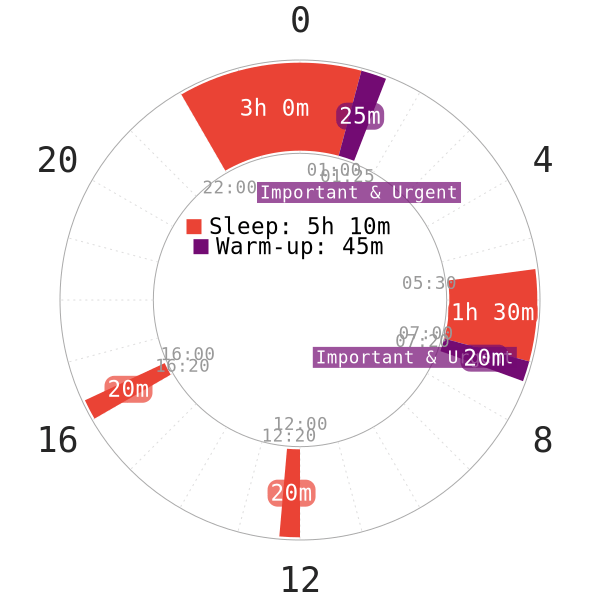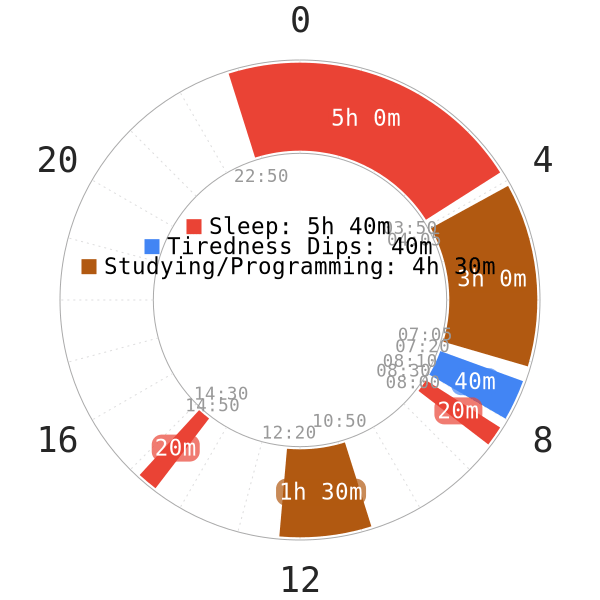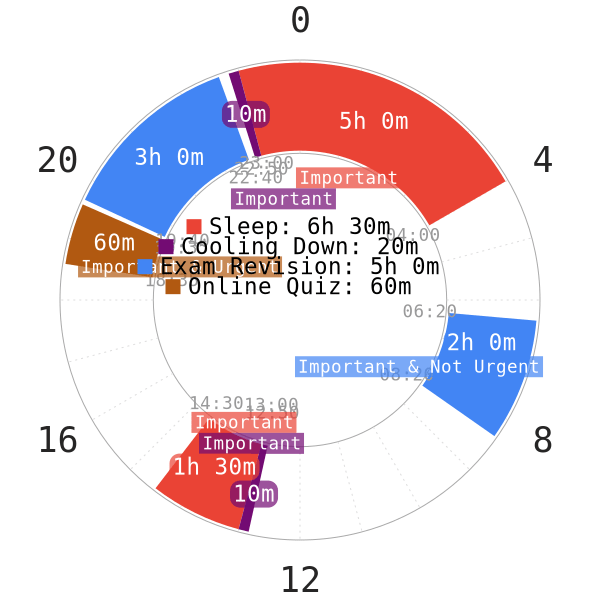Introduction
The Eisenhower Matrix is a time-management system of decision making and prioritization. It helps learners make the most accurate decisions to determine the importance of various tasks1,2,3,4. By actively planning to complete each task, urgency and importance, one can learn to formulate thought processes that smoothen personal objectives.
Furthermore, the use of certain markers such as deadlines, short-term vs long-term goals to comprehensively develop corresponding strategies is also helpful. Each assessment of targeted tasks or duties can also fight off procrastination by boosting personal motivation in achieving different goals.
In tandem with polyphasic sleeping, the Eisenhower Matrix is a potentially useful tool to combat sleep deprivation during adaptation. It does so by focusing on the current tasks and keeping the mind busy. A busy mindset would keep sleep deprivation symptoms at bay nicely. Despite all the extra hours from a polyphasic schedule, it would be pointless if one has poor time management skills. Hence, this tool can also be a long term guide to better time-management skills during waking hours.
Being able to effectively manage time often results in:
- Fewer human errors during execution
- Better organization of tasks
- Fluent execution of workflow and planning
- More satisfaction
- Better results
- Faster accomplishment of personal goals4.
This blog post will present the premises behind the Eisenhower Matrix, how polyphasic sleepers can improve their productivity by manipulating time in their hands.
Content
How the matrix works
The US President Eisenhower’s powerful work ethics has helped him accomplish various groundbreaking projects in his life. He claimed, “I have two kinds of problems, the urgent and the important. The urgent are not important, and the important are never urgent”3.
- The message of Eisenhower is to prioritize tasks that are important and deal with urgent tasks timely so that ideally no workload or projects can pile up.
- Preparation and prioritization are keys to balancing the workload. By the time a task is both important and urgent, it is handled briefly. Based on his proposed decision-making method, the table below showcases the matrix concept through the classification and highlight of different types of tasks1,2,3.
| Priority | Not Urgent | Urgent |
| Important | B Tasks – Important tasks that can delay but require constant attention. | A Tasks – Highly important issues to deal with immediately due to certain consequences. |
| Not Important | D Tasks – Avoid these tasks completely. | C Tasks – Urgent but not the most important. Someone else can take care of these tasks right away or move to another date. |
Table 1. The Eisenhower Matrix
Analysis
The 4 types of tasks mentioned in Figure 1 have 4 categories:
- Important & Urgent Tasks:
One has to deal with these tasks first and foremost. They can leave dire consequences if not handled in time1,2. Examples: putting out a house fire2, treating a snake bite, completing an online homework assignment in the next 15 minutes, etc. For this reason, A tasks have 2 subtypes: Those that are last-minute and those that pop up unexpectedly.
- Important & Not Urgent Tasks:
These tasks are important but there is no need to complete them right away1,2. Rather, they can span through weeks or months. Examples: Undergraduate thesis (due in 3 months), economics essays (due in 1 month), or changing a new health insurance plan (in 2 weeks). If one delays these tasks excessively, these tasks will move to the first category (Important & Urgent).
- Not Important & Urgent Tasks:
These tasks appear to be urgent, but not important in nature. It can be potentially tricky to classify tasks into these categories due to personal assessment of importance.
The solution is to protect the time1. For example, if someone insists on talking in person, call them first to figure out how important it is to require such attention. These tasks are usually interruptions and disruptions in the current workflow. They can be annoying or worthy enough of attention, but are insignificant in essence1,2.
- Not Important & Not Urgent Tasks:
Contrary to all other categorized tasks, it is possible to severely delay these tasks or not do them at all if necessary. They are usually time wasters1,2,3. Examples include: Personal entertainment, reading random blog posts or news, watching TV, etc.
What to Prioritize
Strategically speaking, tasks A and B deserve a lot of attention and energy to finishing them.
- However, even though Category 2 does not require immediate attention, their long-term nature often demands certain planning of smaller tasks that lead up to finishing them. Thus, they are often perpetual tasks that need a lot of monitoring on a regular basis to ensure the maximum efficacy.
- With enough practice, learners can fully use the Eisenhower Matrix to their best ability without sacrificing too much time to determine each task’s importance.
Practical applications in polyphasic sleep
In addition to knowing how the Eisenhower Matrix works, it is necessary to consider polyphasic sleeping scheduling as part of the matrix. Up to date, only a couple polyphasic sleepers in the community have used the Eisenhower Matrix and reported decent results. This section will detail a couple ways to demonstrate how polyphasic sleepers can utilize the matrix.
The following factors should be in consideration:
- Sleep deprivation
- Chronotype
- Patterns of tiredness dips
- Scheduling of polyphasic sleep blocks
Sleep deprivation
During polyphasic adaptation, sleep deprivation is present on different levels. Some individuals are more resistant to the effects of sleep deprivation. They can have a strong immune system or high motivation to complete more activities and interests. Meanwhile, some can only tolerate a certain amount of sleep reduction. These individuals do not have the genetics, sleep requirements, or motivation to gain many waking hours.
However, stage 3, the most potent threat that causes oversleeps, is something to be very wary of. Thus, it is very important to prepare for stage 3 right from the beginning of adaptation. Plan a lot of engaging different activities to keep the mind occupied as a means to “distract” sleep deprivation effects.

STRATEGY
In the napchart above, the most ideal way to combat sleep deprivation during adaptation is to set up multiple intriguing activities. This would serve to capture the brain’s attention, temporarily making it forget sleep deprivation’s effects. Below are some ways to approach this:
- If sleep inertia and sleep deprivation would hinder the productivity of waking hours, the priority upon awakening should be to warm up after a core sleep/nap.
- For example, spend the first half an hour doing jumping jacks, chores and other moderate physical activities to shake those symptoms off as fast as possible.
- Despite looking simple, these activities can be Important & Urgent Tasks to ensure that the body can muster energy to tank through sleep deprivation until the next sleep block. No one should delay these simple tasks.
- If more intense sleep deprivation periods persist during waking hours, these physical activities can go into action again. Alternatively, do them more often for brief moments before resuming the other necessary tasks
- This decision of using warm-up tasks also paves the way for the Pomodoro Technique to be more efficient.
- It is also possible to combine both the Eisenhower Matrix and the Pomodoro Technique to achieve a more rhythmic workflow. This would result in an alternation between taking small breaks and focus.
- If sleep deprivation levels are mild, other Important & Not Urgent Tasks can start right after awakening.
Chronotype
Polyphasic sleepers can use chronotype to their advantage by locating important tasks to their personal favorite hours. As mentioned in the Pomodoro blog post, they can use their active mindset to reliably handle these tasks.
However, it is necessary to also fully prepare for important/urgent tasks at non-preferred hours. As a result, chronotype is usually low on the list of deciding factors.
Patterns of tiredness dips
Tiredness dips refer to moments of drowsiness or sleepiness as sleep cues to schedule a sleep block.
- It is usually easy to ignore mild tiredness dips. These include slight yawns, minor daydreaming-like moments; in general, they do not affect overall performance and productivity.
- However, major tiredness dips often indicate that sleep time is around the corner. Examples include big yawns, some impairment of attention span and more difficulty carrying out desired tasks.
During polyphasic adaptations, a lot of tiredness dips will occur during the day as part of adaptation. In addition, they may occur at random hours or at specific hours. Below is an example on prioritization against tiredness dips.

An Everyman 2 sleeper has a consistent energy dips around noon and before the first nap. This is an ongoing adaptation in Stage 4 as tiredness patterns have become consistent.
- The studying/programming task(s) are for alert hours after the core.
- These activities also come to a halt after the sleeper completes a sufficient workload before major tiredness dips set in.
Thus, it is better to avoid ideally any important tasks that require a lot of mental processing and cognitive performance. In addition, these tasks should not be around these hours to ensure maximum efficiency. These energy dips are also bound to expand during the harsher adaptation stages (Stage 3). Therefore, it is more necessary than usual to deploy different methods to stay awake before engaging in important tasks.
Polyphasic Sleep Scheduling
When it comes to scheduling, it is important to sleep by the minute during adaptation for all sleep blocks on a personal schedule. Thus, all core(s) and nap(s) should be treated as Important and Urgent tasks. How urgent they are depends on how much wake time remains before a sleep session.

Outline
Take a look at the example of a Siesta sleeper. During normal waking hours as shown in the afternoon, regular tasks are scheduled to complete depending on their urgency. A couple things to note:
- The online quiz is due by midnight on that day (Important & Urgent). It takes up to 60 minutes to complete.
- However, the quiz is not as important as the incoming 2 exams on Programming and Physical Chemistry. Both of these will be due in the next 4 days (Important & Not Urgent).
- The sleeper assesses the importance via the difficulty to revise and complete the quiz. As a result, he needs more time on reviewing the materials for the more challenging Programming and Physical Chemistry courses.
The priority of sleep
The most important task in polyphasic sleeping (especially during the adaptation period), however, is sleep.
- Getting a proper amount of rest as on the schedule and properly maintaining a polyphasic schedule is necessary to obtain quality sleep. This would help sustain performance on various tasks, especially during adaptation.
- Up to date, a handful of sleep logs have revealed that a couple of polyphasic sleepers sometimes forgot to take their scheduled naps during the adaptation period because of trivial reasons. Examples include absent-mindedness and being occupied with other priorities.
- To show that it is imperative to follow the sleep schedule, both sleep blocks of the Siesta schedule are Important. As it gets closer to each sleep block, these sleep blocks become more Urgent.
- Thus, it is also necessary to consider cooling down before each sleep block to reduce sleep onset latency. This would allow the brain more time to slow down and enter a slow-wave state.
- Cooling down can also be an Important activity. It also becomes more Urgent with less time remaining for each sleep block. Inexperienced sleepers should dedicate some more time to preparing for their sleep.
After the adaptation phase, the majority of polyphasic schedules tend to become more flexible. Thus, napping in general may have less priority than other commitments depending on what tasks are more important at hand. This helps accommodate daily timetables more easily in case nap or core times have to delay. With all tasks considered, it is important to stop the current workload where necessary to clear the path for sleep to set in.
Conclusion
In sum, polyphasic sleepers who seek more motivation to make use of more waking hours can rely on the Eisenhower Matrix. They should be able to learn to make better decisions on different types of tasks. Time management is a key factor in sustaining motivation to fully take advantage of the extra hours.
The Eisenhower Matrix provides insights into what tasks can be important and urgent; these may vary from person to person. Regardless, by incorporating the matrix into a polyphasic lifestyle, polyphasic sleepers can learn more about the utmost importance of maintaining a proper adaptation period. This will also assist them with overcoming tough adaptation symptoms during Stage 3.
Main author: GeneralNguyen
Page last updated: 2 April 2021
Reference
- Jyothi, N. S., & Parkavi, A. (2016). A study on task management system. 2016 International Conference on Research Advances in Integrated Navigation Systems (RAINS). doi:10.1109/rains.2016.7764421
- Bast, F. (2016). Crux of time management for students. Resonance, 21(1), 71–88. doi:10.1007/s12045-016-0296-6
- MFONDOUM, Alfred Homère NGANDAM, et al. “Eisenhower matrix* Saaty AHP= Strong actions prioritization? Theoretical literature and lessons drawn from empirical evidences.” IAETSD-Journal for Advanced Research in Applied Sciences 6: 13-27.
- Gajewska, Paulina, and Katarzyna Piskrzyńska. “Leisure time management.” Forum Scientiae Oeconomia. Vol. 5. No. 1. 2017.
